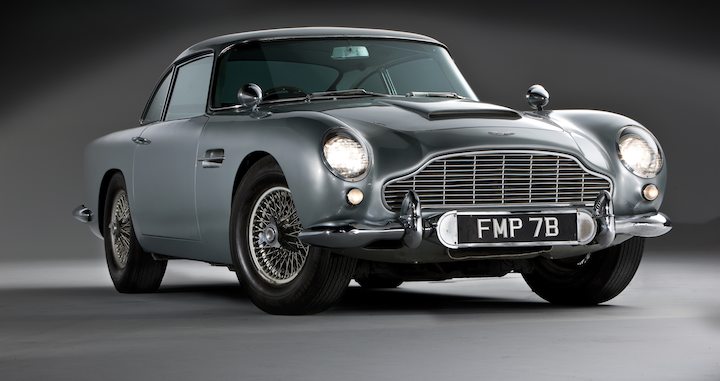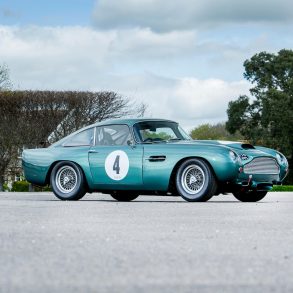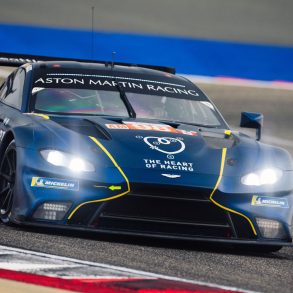Bond. James Bond. It is nearly impossible to think of the James Bond character without visualizing the iconic Sean Connery playing the commanding lead. In seven of these early Hollywood blockbusters, alongside Connery was the car he would always drive through the mayhem of blazing guns and thrilling car chases, the iconic Aston Martin DB5.
Forming the Aston Martin Company
Aston Martin was founded in 1913 by two English businessmen, Lionel Martin and Robert Bamford. They operated a small garage on Callow Street in West London and sold the Singer brand of cars while servicing GWK and Calthorpe vehicles.
After two years, the garage had made enough money for the two to consider forming a new company to produce their own automobiles. They decided they should venture into building distinctive, high quality sports cars that would not only be exhilarating to drive but also beautiful to behold.
The Lead up to the DB5
Lionel Martin raced in his spare time at the local ‘Aston Hill Climb‘ held regularly on a stretch of road nearby the factory in Hertfordshire. When Martin and Bamford were thinking about a name for the company, they decided on the name ‘Aston’, in honor of the hill climb, and Lionel’s last name, ‘Martin’, and called it ‘Aston Martin’.
In February 1947, the company was purchased by David Brown, a wealthy British industrialist who owned a tractor business. His company possessed the expertise in constructing gearboxes and tractors, so was thrilled at the possibility of owning the well-known British manufacturing company, Aston Martin.
Brown visited the company’s headquarters in Feltham and test-drove the Atom, their stylish new prototype vehicle. He thought the Atom handled well, but he felt the car’s four-cylinder pushrod engine did not have the power he desired. However, with the potential he saw in the company, he went ahead and purchased it for £20,500.
Later that same year, Brown heard that Lagonda cars was in financial trouble and up for sale. He was not initially interested in the purchase but visited the company anyway and met Lagonda’s engine designer, W. O. Bentley.
Bentley had been working on designing a new 2599 cc 6-liter V6 engine, the KB6. Brown thought the engine would be perfect for his new generation of Aston Martins and even though the liquidator was seeking offers as high as £250,000, he submitted a lower offer and crossed his fingers.
To his surprise, the other bidders dropped out, and Brown bought the Lagonda Car Company for £52,500. The purchase not only included the entire Lagonda Company but also the rights to Bentley’s new engine. He combined his newly acquired asset with Aston Martin, so they could share resources and workshops.
Aston Martin Atom
The Aston Martin Atom prototype was designed as a saloon, but Brown craved a convertible, so he had the chassis redesigned to accommodate an open top.

The Atom became the first model produced under Brown’s direction. It was powered with Bentley’s the new V-6 engine he had designed at Lagonda and was named the Aston-Martin DB1. It was the first Aston Martin model that sported Brown’s initials, D.B.
Brown recognized the excellent racing potential for his Aston Martin cars so in April 1950, he launched his company’s racing efforts with the DB1 and then the DB2. Both cars competed well in their own class but were never able to contend for an outright victory.
Purpose-built Sports Cars
Brown determined that in order to win races, the company needed to produce a purpose-built sports car. The effort resulted in an Aston Martin DB3S which made its Le Mans debut in 1952. The car quickly showed its potential as a competitive racer.
In 1953 the DB2/4 was introduced, followed by the DB2/4 Mark II in 1955, the DB Mark III in 1957, and the Italian-designed 3.7L DB4 that began production in 1958.
The culmination of Brown’s customer/works racing program occurred in 1959 when the company’s DBR1 claimed victory in the World Sports Car Championship. The highlight of the program was Aston Martin’s outright win at the 24 Hours of Le Mans.
All of Brown’s DB models helped the company to establish a highly favorable racing pedigree. The DB4 especially stood out. The DB4 was the first Aston Martin to set the aesthetic and spiritual framework for the company that is still with us today. When compared with earlier versions of the car like the DB2, the DB2/4, and the DB Mark III, the DB4 brought together modern chassis technology with an exceptional new state-of-the-art inline-six engine that developed over 240 hp.
The Aston Martin DB5
In 1963, Aston Martin’s DB5 was introduced to the world. The new car was designed by Italian coachbuilder Carrozzeria Touring Superleggera and was an evolution of the previous DB4 models.

The DB5 brought Aston Martin even closer to the Grand Touring ideal. It kept all of the outstanding elements of the DB4 including the Touring bodywork and also several upgrades.
The engine was enlarged from the 3.6 liter engine in the DB4 Series V to a more modern 4.0 liter all-aluminum straight-six engine that produced 282 hp and 288 foot pounds of torque and gave the car a top speed of about 145 mph (233 km/h).

Buyers were able to choose either an exceptionally robust new 5-speed manual transmission from ZF or a Borg-Warner 3-speed automatic, both with three SU carburetors.
The new car had a quite luxurious interior. It was more refined, comfortable, and above all, exceptionally beautiful for the time. The DB5 came equipped with attractive reclining seats, full leather trim in the cabin, electric windows, wool pile carpets, chrome wire wheels, twin fuel tanks, an oil cooler, and even a fire extinguisher.

All of the DB5 models were configured as a 2+2 and had two doors. Like the previous DB4, the new DB5 used a live rear axle. From every angle, the design of the new DB5 enjoyed a lightness of touch that fluidly blended its Italian origins with the neat simplicity of the British design.
Shortly after the new DB5 was introduced, a higher performance power package became available. It incorporated hotter cams and upgraded carburetors for a breathtaking 325 hp. A total of 65 of the new Vantage coupes were produced between 1963 and 1965.

All this additional power resulted in astounding performance for a car in the 1960s. The regular DB5 took around 8 seconds from 0-60 mph and had a top speed of about 145 mph with the tallest available final drive. However, the Vantage performance pack dropped the 0-60 time down to 6.5 seconds, almost unheard of in a regular production car in 1963.
Even though the Aston Martin DB5 is visually nearly identical to the DB4, sales continued to be brisk. Many feel that much of the reason lay in clever marketing by the company.
When all the gadgets appeared in James Bond’s Silver Birch DB5 in the blockbuster film, Goldfinger, many considered it the best-looking Aston Martin ever produced. Although both the DB4 and the DB5 shared nearly the same body, the beauty of the DB5 excelled when one looked under the hood (bonnet).
Not only had the Aston Martin engineers enlarged the engine to 4.0 liters but the car also used the same three carburetors that had helped make the earlier Vantage so impressive. The DB5 also used the Vantage’s flared-in headlamps and a new ZF fully-synchronized 5-speed gearbox topped off the package.
When compared to the previous edition DB4, the new DB5 chassis changes included adopting Girling’s disc brakes previously used on the DB4GT and its larger 15-inch wheels. The DB5 also incorporated several other improvements including hydraulic brake servos and electric windows.

Some 23 DB5 convertibles were produced by the company. There were also 12 ‘Shooting Brake’ models designed by Harold Radford, a renowned British coachbuilder.
Aston Martin DB5 Specifications
| Price when new | £4,175 (Saloon), £4,490 (Convertible) |
| Engine | DOHC Inline straight six, 4.0L (3995 cc) |
| Power Output | 282 bhp (286 PS; 210 kW) @ 5500 rpm |
| Transmission | ZF 5-speed or optional 3-speed Borg-Warner automatic |
| Brakes | Twin servo-assisted Girling solid discs (front & rear) |
| Weight | 1,502 kg (3,311 pounds) |
| Front Suspension | Telescopic shocks |
| Rear Suspension | Double-acting lever-arm shocks |
| Acceleration | 0 – 60 mph (97 km/h) time 7.1 seconds |
| Top Speed | Approximately 142 mph (228 kph) |
DB5 Vantage
A higher performance version of the DB5 was introduced in 1964. The more prestigious Vantage model was fitted with either 3 SU HD-8 side-draft or higher-quality Weber carburetors and revised camshaft profiles. These improvements contributed to the car offering even greater top-end performance but this was at the expense of overall flexibility. The engine produced 325 bhp (330 PS; 242 kW) at 5,500 rpm. A total of 65 of the DB5 Vantage coupes were built and 9 convertibles with the higher powered engine.
Between October 1965 until October 1966, the final 37 Aston Martin coupes were used to make a “short chassis” version of the convertible model. These cars actually had the same wheelbase as the other DB5s but they feature new split front and rear bumpers that would be used in the upcoming DB6 model.
Aston Martin DB5 Shooting Brake
A prototype Aston Martin DB5 shooting-brake version of the car was custom-produced by the factory Brown and another 11 (possibly 12) coupes were custom modified by an independent coachbuilder, Harold Radford. This version used Triumph taillights that were also used in the DB5. Over two years of production, Aston Martin built over a thousand of the DB5 model.

The James Bond Films
The company wanted to promote the car and found a unique opportunity to use company owner David Brown’s contacts to convince the producers of the new James Bond film, Goldfinger, to feature his new DB5. In the film, the car was fitted with numerous incredible gadgets to thwart evildoers in their quest to eliminate the movie’s central leading character, James Bond.
The DB5 Commemorative Edition
In 2018, Aston Martin announced it was building 25 new commemorative DB5s in partnership with EON Productions, the company that produces the James Bond films. The selling price was be an astounding $3.4 million.
Each of the new DB5s features aluminum body panels that cover the steel chassis. All of the cars are finished in the exact same Silver Birch paint as the original car in the movie. All of the car replicates have the exact original 4.0-liter naturally aspirated straight-six engine that was in the original car and deliver just a shade under 300 horsepower.
Each of the cars also have an identical ZF 5-speed manual gearbox with a limited-slip differential. Coilover suspensions are at the front and there’s a live rear axle and manual rack-and-pinion steering to complete the package.
The new Commemorative Edition DB5s feature several functional spy gadgets similar to the original car in the movie. Most of the functions can be operated from inside the car and are mechanically nearly identical to the original DB5 in the movie.
According to the company, the DB5 Goldfinger Edition will be only the first of Aston Martin’s Continuation models. The company also has plans to produce replicas of both the DB4 GT and the DB4 GT Zagato.
Production of the new Commemorative Edition DB5s resumed in July 2020 after the company shut down for several months because of the coronavirus pandemic. Each car requires 4,500 total hours of what is called, “meticulous construction”. The price was set at $3.4 million and the company says all of the 25 replicas have been sold. Deliveries are scheduled to begin later this year
In 2001, the father of Aston Martin’s DB series of cars, David Brown was knighted by Queen Elizabeth for services to British Industry. He passed away in September 1993 in Monte Carlo. Brown’s legacy however lives on in the entire DB series of exceptional sports cars, the most famous of which was the unforgettable Aston Martin DB5.











Beautiful car, great movies…
It is a beautiful automobile and a perfect match for Sean Connery.
Almost everyone who knows James Bond knows Aston Martin, the perfect car for any action-packed adventure. Thank you for the read!